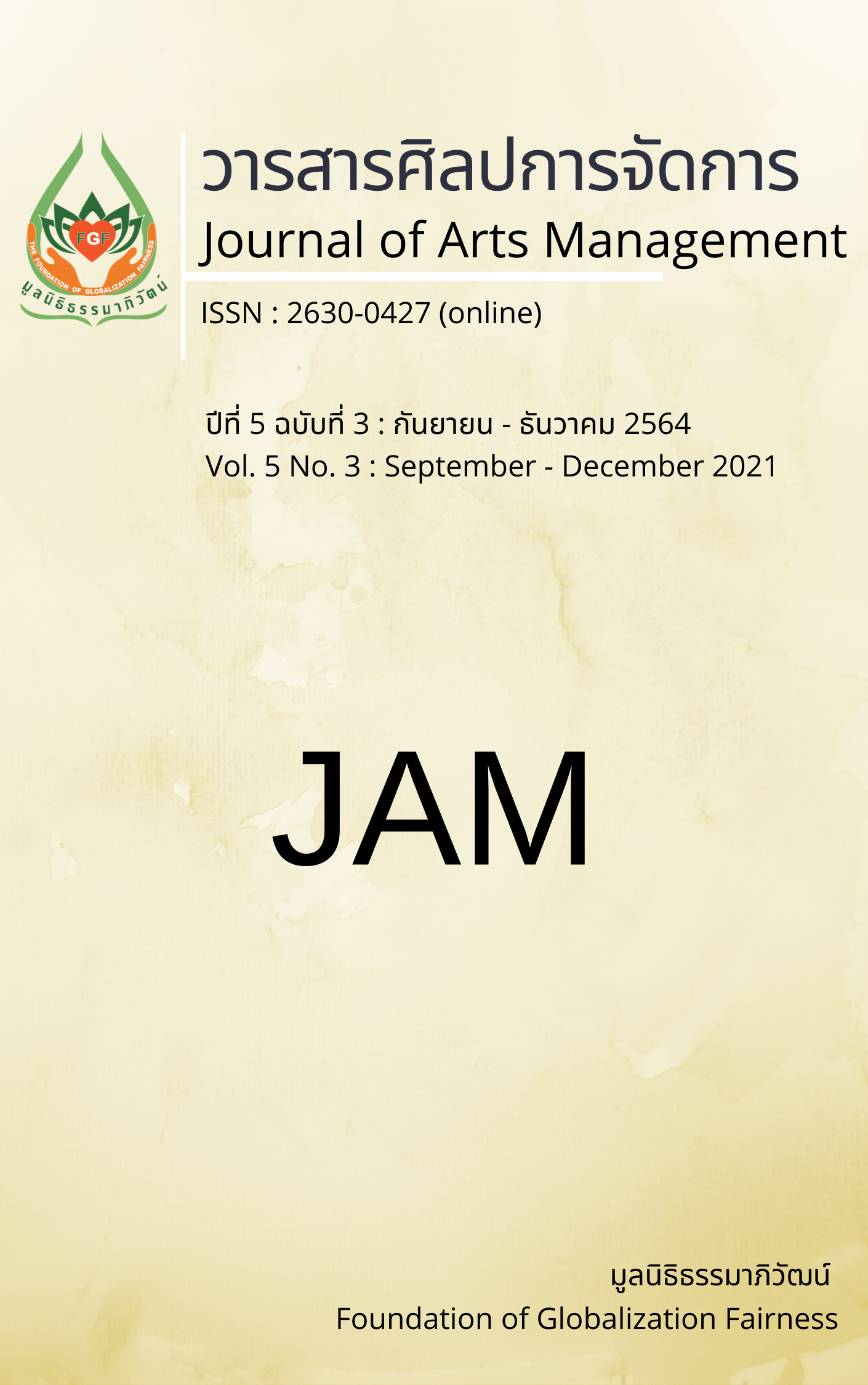A Causal Relationship Model of Factors Influencing the Performance of Small and Medium Enterprises in Thailand
Main Article Content
Abstract
The objectives of this research were to 1) study innovative organization, competitive advantage, entrepreneurship, and performance of small and medium enterprises (SMEs) in Thailand; 2) investigate the influence of entrepreneurship, innovative organization, and competitive advantage on the performance of small and medium enterprises (SMEs) in Thailand. The sample in this study was 384 SMEs in Thailand, which was determined according to Krejcie and Morgan’s criteria at 95% confidence and 5% error and selected by stratified and purposive random sampling. The instrument for collecting data was a questionnaire with a reliability of .834. Data were analyzed using frequency, percentage, mean, standard deviation, Pearson’s product-moment correlation, and structural equation modeling (SEM) to test hypotheses. The research result showed that 1) the average of entrepreneurship, innovative organization, competitive advantage, and performance of SMEs as a whole and each aspect is at a high level; 2) the proposed model adequately explained the empirical data with fit indices including c2 =267.004, df =92, p=.000, c2/df =2.902, GFI =.933, and RMSEA =0.075. The influence of the variables in the model was as follows:
1. Entrepreneurship had a direct, positive influence on an innovative organization and competitive advantage and an indirect, positive influence on competitive advantage and performance.
2. Innovation organization had a direct, positive influence on competitive advantage and performance and an indirect, positive influence on performance.
3. Competitive advantage had a direct, positive influence on performance.
It also showed that entrepreneurship, innovative organization, and competitive advantage could jointly predict 64% of SMEs’ performance. The findings can be used as a guideline to create growth and competitiveness of SMEs.
Article Details
Views and opinions appearing in articles in the Journal of Arts of Management It is the responsibility of the author of the article. and does not constitute the view and responsibility of the editorial team I agree that the article is copyright of the Arts and Management Journal.
References
Aaker, J. L., Benet-Martinez, V., & Garolera, J. (2001). Consumption Symbols as Carriers of Culture: A Study of Japanese and Spanish Brand Personality Constructs. Journal of Personality & Social Psychology, 81(3), 492-508.
Abiodun, T. S. (2016). Impact of strategic orientations on performance of Small and Medium Enterprises: The roles of entrepreneurial orientation in promoting economic development. International Journal of Economics, Commerce and Management United Kingdom, 4(4), 206-219.
Asad, M. (2016). Moderating effect of network ties on the relationship between entrepreneurial orientation, market orientation, and performance of MSES. A Research Journal of Commerce, Economics, and Social Sciences, 10(2), 74-81.
Brown, M. W., & Cudeck R. (1992). Alternative ways of assessing model fit. Sociological Methods & Research, 21(2), 230–258. https://doi.org/10.1177/0049124192021002005
Byrne, B. M. (2001). Structural equation modeling with AMOS: Basic concepts, applications, and programming. Lawrence Erlbaum.
Chatriwisit, R. et al. (2010). Strategic Management (2nd ed.). Aksorn Ngerndee.
Chutiwong, N. et al. (2011). Analysis of factors influencing innovation organization in Thailand. Business Administration Journal, 34(130), 47-58.
Cronbach, L. J. (1970). Coefficient alpha and the internal structure of tests. Psychometrika, 16(3), 297-334.
Decharin, P. (2005). The Path from Strategy to Practice with Balanced scorecard and Key performance indicators. Chulalongkorn University Printing House.
Decharin, P. (2008). Balanced Scorecard. Deep knowledge in practice (6th ed.), Chulalongkorn University Printing House.
Department of Business Development. (2020, January 10). Annual Report 2020. https://www.dbd.go.th/news_view.php?nid=469419146
Fehr, E., & Falk, A. (1999). Wage rigidity in a competitive incomplete contract market. Journal of Political Economy, 107, 106-134.
Fuller, G. F. (2000). Fall in the elderly. American Family Physician, 61(7), 2159-2168.
Fuller, G. F. (2004). Corporate ethical futures responsibility for the shadow on the future of today’s ethical corporations. John Wiley & Sons.
Hambleton, R. K. (1984). Validating the test scores. In R. A. Berk. (Ed). A guide to criterion –referenced test construction. (199 – 223). The Johns Hopkins University Press.
Hamel, G., & Prahalad, C. K. (1994). Competing for the future. Harvard University Press.
Holder, B. J., & Matter, G. (2008). The innovative organization. http://www.geocities.com/ CollegePark/Library/1048/innova.html
Ismail, H. A. (2016). Intention to use smartphone through perceived compatibility, perceived usefulness and perceived ease of use. Journal Dinamika Manajemen, 7(1), 1-10.
Kaplan, R. S., & Norton D. P. (1996). The balanced scorecard: Translating strategies into action. Harvard Business School Press.
Ketthien, W. (2013). Characteristics of entrepreneurs influencing success in running a medium-sized enterprise business in the lower Northeastern province[Master’s Thesis, Rajamangala University of Technology Isan].
Kline, R. B. (2005). Principle and practice of structural equation modeling. The Guilford Press.
Krejcie, R. V., & Morgan, D. W. (1970). Determining sample size for research activities. Educational and Psychological Measurement, 30(3), 607-610.
Laundy, P. (2006). An Innovation Discipline Model. http://www.bpminstitute.org/articles/ article/article/an-innovation-disciplinemodel.html
Leelawattananan, N. (2021, March 1). Investment risk. https://bsc.dip.go.th/th/category/2016-09-06-05-21-02/2016-09-18-10-37-50.
Office of Small and Medium Enterprises Promotion, (2020, January 10). Annual Report 2020. https://www.sme.go.th/th/download.php?modulekey=215&cid=0
Panyindee, S. (2015). Factors leading to the focus on entrepreneurship and the performance of the organization. Journal of Humanities and Social Sciences, 9(2), 47-58.
Porter, M. E. (1990). The competitive advantage of nations. Free Press.
Robbins, S. P. (2005). Essentials of organizational behavior (8th ed.). Pearson Education.
Schermerhorn, J. R., Hunt, J. G., & Osborn, R. N. (2003). Organizational behavior (9th ed.). John Wiley & Sons.
Schumacker, R. E., & Lomax, R. G. (2004). A beginner’s guide to structural equation modeling (2nd ed.). Lawrence Erlbaum Associates Publishers.
Soltani, S. (2012). Key factors influencing organizational innovation in small rural food industries: Case study of Iran. African Journal of Business Management, 6(9), 3553-3561.
Thienput, D. (2007). Key Performance Indicators. Thai Charoen Printing.
Ulrich, D., & Lake, D. (1991). Organizational capability: Creating competitive advantage. Academy of Management Perspectives, 5(1), 77-92.
Wang, K. Y. (2015). Entrepreneurial orientation and organizational learning on SMEs’ innovation. The International Journal of Organizational Innovation, 7(4), 71-81.
Zainol, F. A. (2011). Entrepreneurial orientation and firm performance: The role of personality traits in Malay family firms in Malaysia. International Journal of Business and Social Science, 2(1), 59-71.


